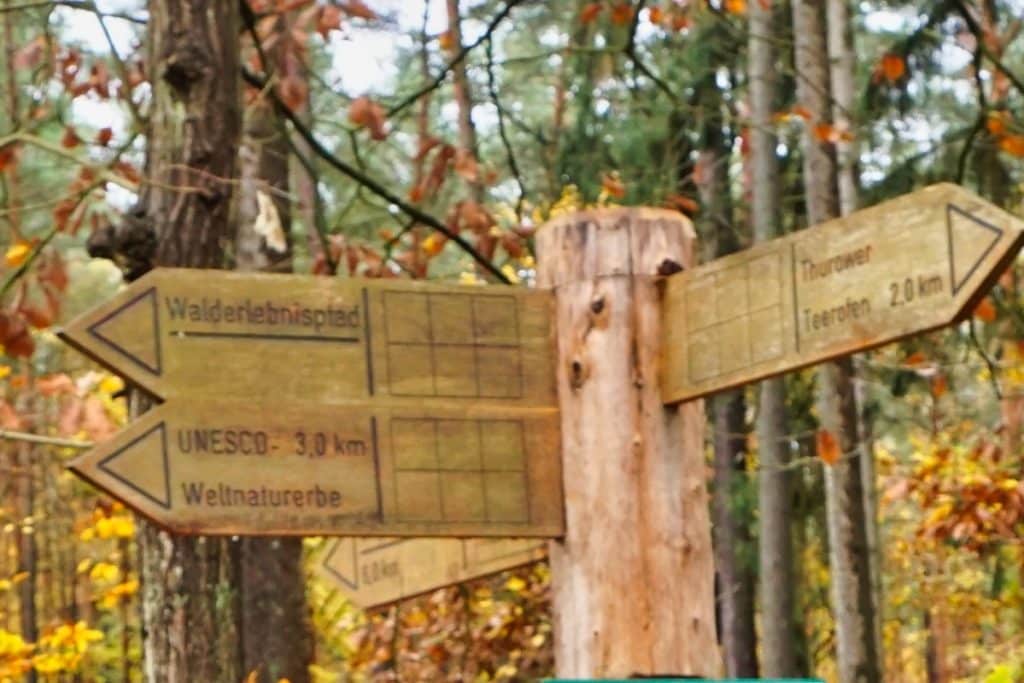I was not at all aware of how many UNESCO sites exist in Germany and what different UNESCO lists exist.
First of all, the question arises:
How to become a UNESCO World Heritage Site?
The process of inscription on the UNESCO World Heritage List is a lengthy and detailed process that requires the participation of both the local and international community. The process begins at the national level and then progresses to the international level.
Before submitting an application, the country concerned must carry out a preparatory study. This study should confirm the significance of the cultural heritage and determine whether it meets UNESCO’s criteria for inscription. The criteria relate to the uniqueness, authenticity and integrity of the cultural heritage in question.
Next, the country concerned must inscribe the cultural heritage on its “Tentative List”. This list contains all the sites that a country could propose for nomination in the future. This list must be submitted to UNESCO at least one year before the actual nomination.
Once the site is on the Tentative List, the country can start preparing the nomination dossier. This dossier contains information about the site, including its history, current status, reasons for its significance and plans for its conservation and management.
The country submits the nomination dossier to UNESCO. After submission, the dossier is reviewed by one or more UNESCO Advisory Bodies. These include the International Council on Monuments and Sites for cultural heritage and the World Conservation Union for natural heritage. These organisations make a recommendation.
Based on the recommendations of the Advisory Bodies, the World Heritage Committee makes the final decision on inscription. The Committee meets once a year to decide on new nominations.
Once inscribed on the World Heritage List, the country is obliged to maintain the condition of the site and to send regular reports on its condition to UNESCO. The World Heritage Committee can place sites that are not properly maintained on the List of World Heritage in Danger or even remove them from the list completely.
Which UNESCO World Heritage Lists exist?
UNESCO maintains various World Heritage Lists to document and protect outstanding sites.
World Heritage List:
This list includes sites of outstanding universal value in the field of cultural heritage. These include archaeological sites, historic cities, building complexes, cultural landscapes and much more.
World Natural Heritage List:
This list includes unique natural areas that are of outstanding beauty and ecological significance. These can be national parks, nature reserves, marine areas, forests or geological formations.
List of World Heritage in Danger:
This is a supplementary list that includes sites that are in danger of loss or destruction. UNESCO is stepping up its efforts to protect and preserve these sites in danger.
Intangible Cultural Heritage List:
This list includes living traditions, customs, expressions, craft techniques and oral traditions that are significant to the cultural diversity of communities.
Documentary Heritage List:
This lists audiovisual recordings of cultural heritage significance, including films, audio documents, photographic collections and more.

UNESCO – Sites in Germany

Autumn is a wonderful time of year, and if you're out and about in the Mecklenburg Lake District, you're bound to go into raptures. The colourful foliage, the glitter of the sun in the countless lakes and many beautiful hiking trails - it's worth exploring the area.

At Rhine kilometre 555 there is a 123-metre-high slate rock, the world-famous Loreley Rock. Who doesn't know the stories about the mysterious Loreley, which is said to have been responsible for many a shipwreck on the Rhine?

The cable car from Koblenz reaches the top station and we get off. High above the city, on the right side of the Rhine, lies Ehrenbreitstein Fortress on Mount Ehrenbreitstein. It already looks big and mighty from the Rhine valley, but we will explore whether it is really that impressive.

Old books and libraries have an almost magical attraction for us. In Weimar there is a library that you simply have to see. The Duchess Anna Amalia Library is certainly one of the most beautiful libraries in Germany.

Koblenz is where the Moselle flows into the Rhine. Here is one of the most visited places in the city, the German Corner in Koblenz with the monumental equestrian statue of the German Emperor Wilhelm I.

Not far from Weimar is Belvedere Palace, built for Duke Ernst August I, with its beautiful park and orangery with its many exotic plants.

You can feel it immediately when you pass the door of the Arnstadt city brewery: It's not just the history that clings to the old brick walls of this landmark building. It's the living tradition that resonates in the air, a homage to the age-old craft of brewing beer that manifests itself in every sip…

The garden gnome is on the UNESCO list, who would have thought it. Yet this figure divides garden owners to this day. Some hate the little men and can't imagine anything worse in their garden. Others love the gnome and can't get enough of it.

The Bauhaus is a world-renowned movement that has had, and continues to have, a profound influence on art, architecture and design. Its roots are in Weimar, a city considered the cradle of this "revolutionary" movement.

The different museums on Berlin's Museum Island often make it difficult to decide which one to visit. The Bode Museum is not only worth a visit from an architectural point of view, the interesting exhibitions with wonderful exhibits particularly captivated me.

Weimar has always captivated people. So it is not surprising that Goethe felt at home here. One of the most famous Germans died in Goethe's home on the Frauenplan in 1832.

High above Eisenach on a mountain range of the Thuringian Forest lies the Wartburg at an altitude of over 200 meters. It is one of the most visited places in Thuringia and offers not only castle and history lovers an unforgettable visit. The view over the region is simply indescribable!

He comes flying towards me and at this moment I think about whether it was the right decision to make myself available as a "guinea pig". My arm trembles a bit as the huge bird lands on it….

A visit to Potsdam without strolling through Sanssouci Park is only half a visit. The palace park and palace are Potsdam's most famous sights worldwide

The Museum Island in Berlin-Mitte is one of the places to go in Berlin for every art and culture lover. Several museums with permanent and temporary exhibitions attract - I was attracted by the Pergamon Museum.

In the past, everyone knew Erfurt watercress. Today there is only one professional watercress grower left in the former watercress capital of Germany. But the plant is still popular today.

If you walk along the Grosse Allee through Sanssouci Palace Park, you come to the last important Baroque palace complex in Prussia, the Neues Palais in Potsdam. For me, the New Palace with its adjacent buildings is one of the most beautiful buildings in the palace park.

The Belvedere on the Klausberg is a UNESCO cultural heritage site in the Berlin-Potsdam cultural landscape. It is located in the north-western part of the Sanssousi Park.

The New Orangery stands on the northern edge of the Sanssouci Park on the Bornstede ridge. However, this does not resemble a huge greenhouse, as is often the case in other parks, but is an impressive complex in the style of a palace and does not bear the name Orangery Palace for nothing.

The park of Sanssouci Palace has many surprises in store. Not only beautifully designed parks and extensive paths along shady trees, but also buildings such as the Roman Baths or Charlottenhof Palace.

Potsdam is famous for the beautiful summer palace Sanssouci with the palace park and its numerous landscaped gardens. During a walk through the park you can admire the Chinese House and the Dragon House.

Holger from Berlins Taiga invited me to an extraordinary guided tour with the theme "Park Babelsberg in the shadow of world history" and I was really excited about what to expect.

on the way in the large housing estate Siemensstadt I've been living in Siemensstadt for over 25 years now, but I haven't really paid much attention to the architectural history of my neighborhood. Sure, I have seen tourist groups walking along here from time to time and I also know the signs on some rows…

If you enter Sanssouci's Schosspark from the Green Gate, the main entrance, you can't miss the Friedenskirche (Peace Church) in the Marly Garden. It is worth planning a visit, the church is exceptional.

You can't miss Regensburg Cathedral on a walk through the city. We were also drawn to the city's most important church.

I wasn't just in Bamberg to move from one brewery to the next. Of course, I also wanted to gather some city impressions and discover Bamberg's sights.

If you look at pictures of Bamberg, you will always see a beautiful half-timbered house on an island. This is probably the best-known and most important building in the city - the old Bamberg town hall.

One of the most impressive buildings in Regensburg is the Old Town Hall on Rathausplatz. Here you can go on a journey of discovery with a guided tour and learn about the history of Regensburg's imperial days.

The World Heritage region Wartburg-Hainich in Thuringia – I was on tour to discover the region and was amazed by its variety. It has something for everyone’s ideal holiday.

I have always wanted to see a canopy path. Fortunately, I had the chance to experience one as part of a PR trip to the world heritage region Wartburg-Hainich.

One weekend every year, I travel with a group of friends. After we had already travelled to Hamburg and Prague in the previous years, we picked Lübeck as our next destination. Arrival: Saturday morning, departure: Sunday afternoon. A short trip to Lübeck.

We have been passing the station Lutherstadt Wittenberg on our commute for ages. So one day, we just got off there. And that was a good idea!

There is no such thing as bad weather. Only inappropriate clothing. So, despite it spitting with rain, we put on our most comfortable shoes, got the umbrellas out and embarked on an expedition through Hamburg. Mostly on foot with the occasional metro or train journey.

The market place in Bremen is located in the centre of the Hanseatic city. These approximately 3500 m2 are one of the oldest places in Bremen and the spot with the most visitors.
